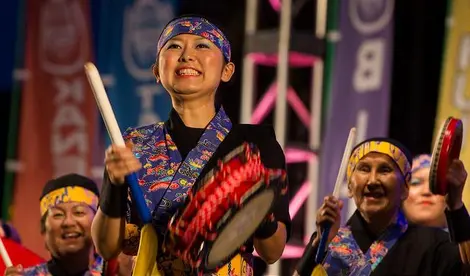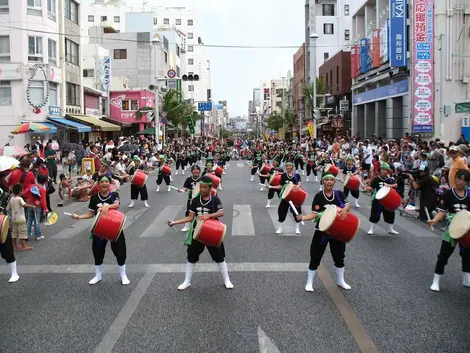The traditional Okinawan art of Eisa 沖縄のエイサー
- Published on : 25/01/2018
- by : Ph.L
- Youtube
Dance in the South Islands
While Okinawa is known for its beaches and beautiful landscapes, the archipelago also has a rich cultural heritage that continues to evolve. This is the case of Eisa, a dance accompanied by drums and songs borrowed from Buddhism, which has become an integral part of Okinawa's popular culture.
From religious tradition to regional folklore
Imported to Okinawa in the sixteenth century by Buddhist monks from central Japan, eisa began as an art to enhance religious ceremonies.
Involving both music and dance, eisa was practiced during funeral ceremonies to accompany the nenbutsu, Buddhist chants intended to appease the souls of the dead.
Eisa has not lost this religious tradition, and we still see these dances today at the end of the Obon festivities that honor the spirits of ancestors descended back to Earth. With parades in the streets and performances by professional groups all over the prefecture, the end of August on the small group of islands is usually heralded by the sound of drums.
Read : Traditional Japanese Instruments
Three types of traditional drums are still used today: the odaiko, a large barrel drum that can sometimes be placed on the foot if it's too large; the shimedaiko, a medium-sized drum that is carried with you; and the paranku, similar to a tambourine. Although once these instruments were only played by men, they can now be played by all.
Eisa, the art of the people
Indeed, the art of eisa was democratized under the Meiji era (1868-1912). And the parades quickly became community events, bringing together people of all ages and all walks of life.
This desire to bring people together gave birth a few years later to the first eisa festivals in the country, the Zento Eisa Matsuri in 1956, and the Furusato Eisa Festival in 1964 - two major events that marked a turning point in the discipline.
Presented in the form of a competition, the festivals popularized Okinawan culture, which has a local religious tradition, throughout the country, turning it into a true emblem of regional folklore. It was therefore a period of great change for eisa, which saw its songs and choreographies modernized, its costumes become more colorful, and its groups more professional.
Today, Okinawa has hundreds of professional and amateur bands that continue to reinvent the art of eisa every day. Each group choreographs their own dances, chooses their own costumes, and builds their own musical universe, to the point that some dancers are totally separate from the religious songs and no longer base their representations on pieces borrowed from the popular music of the Okinawan archipelago.
Where to enjoy the art of eisa in Okinawa
Although many hotels in Okinawa hire professional groups year-round to entertain their clientele, the best season to enjoy Eisa is at the end of summer.
Indeed, several festivals are held on the weekends preceding the Obon period: the Yomitan Village Eisa Festival, organized by the local eisa association in Yomitan which gathers together a dozen groups every year; the Ginowan City Festival; a parade of the 10,000 Naha dancers held on the first Sunday of August in the main street of the city, the Kokusaidori; or the Zento Eisa Matsuri, which continues today and takes place every year in the city of Koza. This is the most famous festival in Okinawa, and welcomes more than 200 000 visitors from all over the world every year!
See : Yomitan village
All the festivals end with fireworks, and entry is free for most of them. It's a great opportunity to discover this traditional local art form at a next to no cost.

Eisa

Eisa drummers















